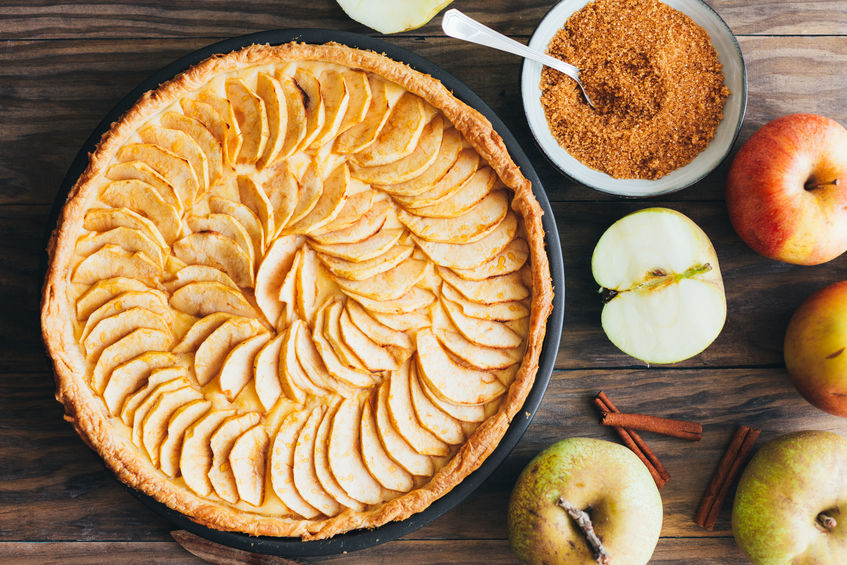
Apple season at Vince’s Market has begun! From the bins outside, to the varieties in-store, we currently have many favourites in stock and a few you may not have tried yet. Let’s break down a few of the Ontario varieties and embark on a little journey around the orchard!
CORTLAND APPLES
Cortland apples are widely grown in Quebec and Ontario and have proven themselves to be well-suited to the freezing temperatures experienced around the Great Lakes. As with all McIntosh varieties, Cortland is at its best when eaten soon after being picked. The sweet flavour fades quickly, as does its crispness. An interesting characteristic of Cortland is that the flesh does not go brown very rapidly after being cut. They’re a terrific baking apple for pies, crisps, or cobblers but also work great in salads or on cheese plates.
MCINTOSH APPLES
The McIntosh apple is a small to medium-sized round fruit with a short stem. It has a red and green skin that is thick, tender, and easy to peel. Its white flesh, sometimes tinged with green or pink, is juicy, tender, and firm, but can soon become soft and bruises easily. The fruit is considered “all-purpose”, suitable both for eating raw and for cooking. It is primarily used in desserts and requires less time to cook than most cultivars.
NORTHERN SPY APPLES
The Northern Spy apple’s skin color is green, flushed with red stripes where not shaded. The white flesh is juicy, crisp and mildly sweet with a rich, aromatic slightly sour, slightly acidic flavor, noted for high its Vitamin C content. Its characteristic flavor is tarter than most popular varieties, and its flesh is harder or crunchier than most, with a thin skin. Spy apples are commonly used for desserts and pies, as well as juice and cider. It is an excellent apple for storage, tending to last long due to late maturation.
GALA APPLES
A great choice for snacking, Gala is a variety developed in New Zealand. It’s got the mild flavor that “picky eaters” prefer, plus a striking bright yellow-red color that also makes it visually appealing. They are mild, with a sweet flavour, and juicy with a crisp, creamy yellow flesh. Gala apples are excellent for eating and salads and their mellow flavour and thin skin make them the perfect choice for school lunches and snacks for kids.
EMPIRE APPLES
The Empire apple is an intense maroon-red, overlying a light green background, that was developed at Cornell University in New York state in the 1940s. Classic old North American varieties—Delicious and McIntosh—are its genetic parents. An ideal lunch-box apple, it doesn’t bruise easily. The Empire is a sweet apple with a crisp texture and bright white flesh. Although they can be stored for a short period, it is best when eaten straight from the tree. It has the characteristic and unusual McIntosh flavor, but perhaps the best way to describe it is like a hint of melon or pineapple or elderflower. It’s best uses are in salads, for applesauce, in baking such as apple pies, or for freezing.
HONEYCRISP APPLES
The Honeycrisp is a modern apple variety, developed in the 1960s and introduced to the market in the 1990s. It’s a medium-to-large sized apple, with a light green/yellow background largely covered with red-orange flush with strong hint of pink if grown in good sunlight. The skin may be flecked with occasional russet dots. The flesh is white, perhaps not quite as bright as a McIntosh style apple, but similarly crisp and not too dense. The flavour of the Honeycrisp is sweet with very little acidity. A juicy and instantly refreshing apple and as its name suggests, a genuinely a crisp/crunchy apple. The Honeycrisp is the apple to snack on, place atop a fresh salad, or pair with cheese, but not well suited for baking.
Not sure what to do with all the apples you’re going to buy? A great way to prepare them for longer storage is to freeze them. All you need to do is remove the core and slice them (if you want to peel them first, that’s completely up to you), and put them on a baking tray in a single layer to freeze flat. Once they’re frozen, transfer them to your preferred storage container and pull out what you need when you need it. It’s super easy and means you always have apple slices on hand for a warm apple pie or crisp, or to make applesauce with.
Should you want to enjoy your apples right away, consider making this:
APPLE PIE BAKED APPLES
INGREDIENTS
- 3 Granny Smith apples
- 3 pink lady apples
- 1 tbsp. warm water
- 2 tsp. cornstarch
- 2 tbsp. butter
- Juice from 1/2 a lemon
- 1 tsp. cinnamon, plus more for sprinkling
- 1/3 c. granulated sugar, plus more for sprinkling
- 1 refrigerated pie crust
- 1 large egg beaten with 1 tbsp. milk (egg wash)
- Caramel, for drizzling
DIRECTIONS
- Preheat oven to 375°F. Peel and dice one green and one red apple. Slice off tops and, using a melon baller, hollow out the remaining apples. Set aside.
- In a small bowl, whisk together warm water and cornstarch.
- In a small saucepan over medium heat, melt butter. Add diced apples, lemon juice, cinnamon, and sugar. Bring to a simmer and cook until apples are tender, about 5 minutes. Add in cornstarch mixture and cook 5 minutes more.
- Place hollowed out apples in a baking dish and fill with cooked apple mixture.
- On a piece of wax paper, roll out pie dough and cut into 4 circles. Slice each circle into thin strips. Make a lattice top on each apple, trimming any excess.
- Brush crust with egg wash and sprinkle with more cinnamon sugar. Bake until apples are tender, and the crust is golden, about 28 to 30 minutes.
- Drizzle with caramel before serving.
We’d love to hear from you! Do you have any special apple recipes to share, or have a favourite apple??
Leave us a comment here or head on over and join in the conversation on Facebook (please ‘Like’ the page if you’re so inclined) and Twitter. If you haven’t already signed up to receive our weekly newsletter which includes our blog, the weekly product feature, the weekly Coterie savings, and our recipe of the week delivered right to your inbox, you’ll find the signup by clicking here.
Let’s catch up soon,
Julie







